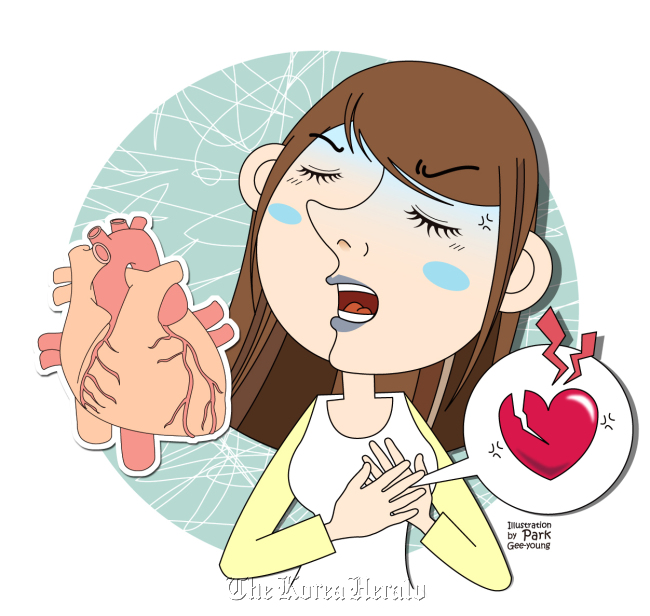 |
Illustration by Park Gee-young |
With a Westernized lifestyle and diet, and an aging society, we live in a time of increasing cancer and cardiovascular diseases.
The classic symptoms of heart disease include chest pain, palpitations, and shortness of breath. Many people with heart disease are unaware of any symptoms, so some people can suddenly develop symptoms having previously thought they were healthy.
Therefore, if you have any symptoms related to the heart, it is highly recommended that a cardiologist examine you. Even if you do not have any symptoms, if you have many risk factors for heart disease, then you should go ahead with more thorough heart tests during your health checks.
Types of heart tests Electrocardiogram
This is a graph of the electrical activity related to the heartbeat, and it is the most standard test of the status of the heart. It can help assess heart status and function, as well as the diagnosis of chronic diseases, such as arrhythmia, myocardial disease, and chronic and myocardial infarction. It can also help detect acute diseases such as heart attacks or lung disease.
Stress test
Similar to the electrocardiogram, this involves attachment of electrodes to the arms, legs and the chest to record electrical activity of the heart during rest and while exercising on a treadmill. This allows observation of the changes in the electrocardiogram, as well as other symptoms such as chest pain and breathlessness (dyspnea) which can be used to evaluate the heart function, including angina, arrhythmia and exercise ability. This test takes approximately 30 minutes. It involves exercise during the test, so may be difficult to perform on those with mobility problems.
Echocardiography
This test uses ultrasound, which is not harmful to the body, in order to assess the heart structure and function, as well as making diagnoses of various heart problems. Issues this test can pick up on include heart valve diseases, such as stenosis or valvular regurgitation; problems with the blood supply to the heart such as heart attack, pericardial disease, heart failure, congenital heart disease, tumor of the heart or surrounding areas, and diseases of the aorta. The test takes approximately 20-40 minutes to complete, but may take up to 1 hour depending on the circumstances. There are no precautions for you to take before having the test, such as fasting or taking medication.
Coronary artery CT
This test uses computerized tomography to look at the coronary arteries that supply blood to the heart. The test shows problems with the blood supply to the heart, and can also involve the use of contrast agents that allow visualization of the arteries more closely. Some people may be sensitive to the contrast agent used, so during health checks, only the coronary artery calcium CT is done to estimate the calcification of the arteries. There are no particular side effects to the coronary artery calcium CT. However, in some cases, your doctor may want to undergo CT angiography using a contrast agent if there are particular symptoms.
Cardiac MRI
This is one of the most popular tests. It uses magnetic resonance imaging, which can also be done to look at other organs. It is a good test for diagnosing myocardial disease, tumors of the cardiovascular system or blood supply problems including angina, and also allows the assessment of heart function. However, as for the CT, it requires adjustment of the heart rate before the test and takes longer than other tests to perform. It is also difficult to perform on claustrophobic patients.
Who should take these tests?
People who have been smoking for a long time, have diabetes or hypertension, have a family history of heart disease, have hyperlipidemia (cholesterol or triglycerides), or are obese are more likely to develop heart diseases. Therefore, heart tests are recommended for these people.
The symptoms of cardiovascular disease vary, and in those who are asymptomatic, the prediction of heart disease is difficult even with testing. Hence, rather than relying on one test alone, it is best that the patient discusses with his or her doctor about the best test that they should have.
 |
Cho Sung-won |
By Cho Sung-won
The author is a doctor at Samsung Medical Center and a clinical associate professor at Sungkyunkwan University School of Medicine. ― Ed.








![[Today’s K-pop] Blackpink’s Jennie, Lisa invited to Coachella as solo acts](http://res.heraldm.com/phpwas/restmb_idxmake.php?idx=644&simg=/content/image/2024/11/21/20241121050099_0.jpg)
